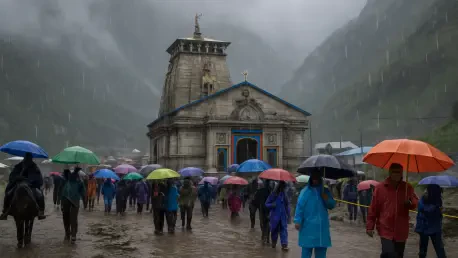In the heart of the Garhwal Himalayas, a sacred journey undertaken by thousands of devotees each year has come to an abrupt pause, raising concerns among pilgrims and authorities alike. The Kedarnath Yatra, a revered Hindu pilgrimage to one of the holiest shrines dedicated to Lord Shiva, has been temporarily suspended for three days due to a red alert issued by the India Meteorological Department (IMD) for intense rainfall and potential landslides in Uttarakhand’s Rudraprayag district. This drastic measure underscores the unpredictable power of nature and its ability to disrupt even the most spiritually significant endeavors. As heavy rains batter the region, rendering travel unsafe, the focus has shifted to ensuring the safety of all involved. This development not only affects the immediate plans of countless travelers but also highlights the broader challenges of managing such pilgrimages in a region prone to severe weather conditions.
Weather Challenges Impacting the Pilgrimage
Navigating Nature’s Fury in Rudraprayag
The suspension of the Kedarnath Yatra stems from a dire forecast by the IMD, which has issued a red alert for extreme rainfall across Rudraprayag and surrounding areas. This warning, signaling a high risk of flooding and landslides, has forced authorities to prioritize safety over the continuation of the sacred journey. Over 23 roads, including four critical routes leading to the Kedarnath Temple, have been closed due to debris and waterlogging, making access nearly impossible. The rugged terrain of the Himalayas, already a challenge for travelers, becomes even more treacherous under such conditions. Local officials are working tirelessly to monitor the situation, deploying teams to assess road damage and ensure that no pilgrims are stranded in vulnerable zones. The decision to halt the yatra, though disappointing for many, reflects a commitment to preventing potential tragedies in an area historically affected by natural disasters during the monsoon season.
Proactive Measures for Pilgrim Safety
Beyond the immediate closure of roads, authorities have implemented a range of precautionary steps to manage the crisis effectively. Emergency response units have been stationed along key points of the pilgrimage route to provide assistance if needed, while regular updates on weather conditions are being communicated to keep devotees informed. The three-day suspension serves as a buffer, allowing time for the rainfall to subside and for infrastructure assessments to be completed. Additionally, coordination between state and district administrations ensures that resources are allocated to clear blocked paths as soon as conditions permit. This proactive approach aims to mitigate risks associated with sudden landslides, a recurring threat in the region, and to reassure pilgrims that their well-being remains the top priority. The temporary halt, though a setback, is a necessary step to safeguard lives against the unpredictable whims of nature in such a high-altitude, weather-sensitive area.
Spiritual Significance and Future Prospects
The Enduring Allure of Kedarnath Temple
Nestled at an elevation of 3,584 meters in the Garhwal Himalayas, the Kedarnath Temple holds profound spiritual importance as one of the 12 Jyotirlingas dedicated to Lord Shiva and a pivotal site in the Char Dham circuit. For countless devotees, the arduous journey to this ancient shrine represents a deeply personal act of faith, often undertaken amidst challenging conditions. The temple, typically accessible from late April or early May to October or early November, sees peak visitation during the milder months of May-June and September-October. Nearby attractions like the Bhairav Temple, Adi Shankaracharya Samadhi, and Vasuki Tal Lake further enrich the pilgrimage experience, offering additional layers of cultural and natural beauty. Despite the current disruption, the enduring allure of Kedarnath continues to draw followers, symbolizing resilience and devotion in the face of adversity, with its remote location only adding to the sense of spiritual fulfillment upon arrival.
Planning Ahead for a Safe Resumption
Looking toward the future, the focus remains on ensuring a safe resumption of the Kedarnath Yatra once the weather stabilizes. Authorities are closely monitoring meteorological updates to determine the earliest possible date for reopening the routes, with a clear emphasis on restoring access without compromising safety. Pilgrims are advised to stay updated through official channels and consider planning their visits during the recommended months to avoid similar disruptions. The local government is also exploring long-term solutions, such as improved infrastructure and early warning systems, to better prepare for seasonal challenges in the coming years. As the situation evolves, the commitment to balancing spiritual aspirations with practical safety measures will be crucial. Reflecting on this pause, it becomes evident that nature’s unpredictability demands respect, and the collaborative efforts to protect devotees during this period set a precedent for future preparedness in managing such sacred yet vulnerable pilgrimage routes.









